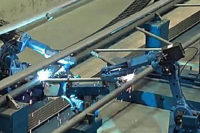Cell Simplifies Complex Welding Tasks

Shelbourne Reynolds has increased welding production by 66 percent thanks to a customized FlexArc robotic welding cell. Photo courtesy ABB Inc.



Hard at work within Shelbourne Rey-nolds Engineering’s Suffolk, UK, manufacturing plant are nearly 100 assemblers and the latest equipment to build attachments for articulated hedge cutting tractors. State-of-the-art CNC, laser steel cutting and powder coat machines have been mainstays of the facility since Keith Shelbourne bought Reynolds Engineering Ltd. in 1972.
Today, Shelbourne Reynolds is known worldwide as a leading designer and manufacturer of pickup and stripper headers for tractors. In fact, half of the company’s products are exported to 50 countries from its Suffolk and Colby, KS, plants.
A little more than two years ago, as part of an effort to fully automate the Suffolk plant, Shelbourne integrated a customized FlexArc robotic welding cell into its production line. Made by ABB Inc., the modular cell features a robot, controller, positioner, welding equipment (power source, welding torches), production monitoring software and horizontal light curtains.
Michael Scarfe, manufacturing manager for Shelbourne Reynolds Engineering, says various header subassemblies are welded in the cell. The products require hundreds of welds, including many complex welds around pipes and tubes. Previously, a team of six manual welders performed these welds.
“We introduced a cut-off point whereby anything that previously took an hour or more to weld was allocated to the robot cell,” explains Scarfe. “[Now], complex welds are performed in one-third the time to a much higher aesthetic standard.”
Equally important, the cell has dramatically increased production and requires only one worker to supervise its operation during each of the plant’s two daily production shifts. This latter benefit enabled Shelbourne Reynolds to redeploy five welders to other production processes, including fast turnaround tasks.
“The idea was always to complement, not replace, our manual operations [because] finding skilled welding and plating staff is very hard,” acknowledges Scarfe. “We [believe in keeping] the people we’ve got and finding ways to utilize their expertise in the manufacturing of other products.”
He says ABB played a key role in optimizing the cell’s performance from the outset, primarily by creating a simulated cell through its RobotStudio software. This simulation reduced onsite setup time, enabling Shelbourne to commence welding operations just three days after cell installation.
The company also likes that ABB monitors the cell remotely to ensure uptime. According to Scarfe, the
supplier continuously receives robot performance data over the Internet using wireless general packet radio services technology.
ABB references this data with mandated operating parameters to spot negative trends and help prevent production problems. Should a problem arise, a short wave service message is automatically sent to an on-call service engineer who immediately accesses a detailed data-and-error log to identify the problem’s specific cause and location.
For more information on robotic welding cells, call 248-391-8622 or visit http://new.abb.com/products/robotics.
Looking for a reprint of this article?
From high-res PDFs to custom plaques, order your copy today!








